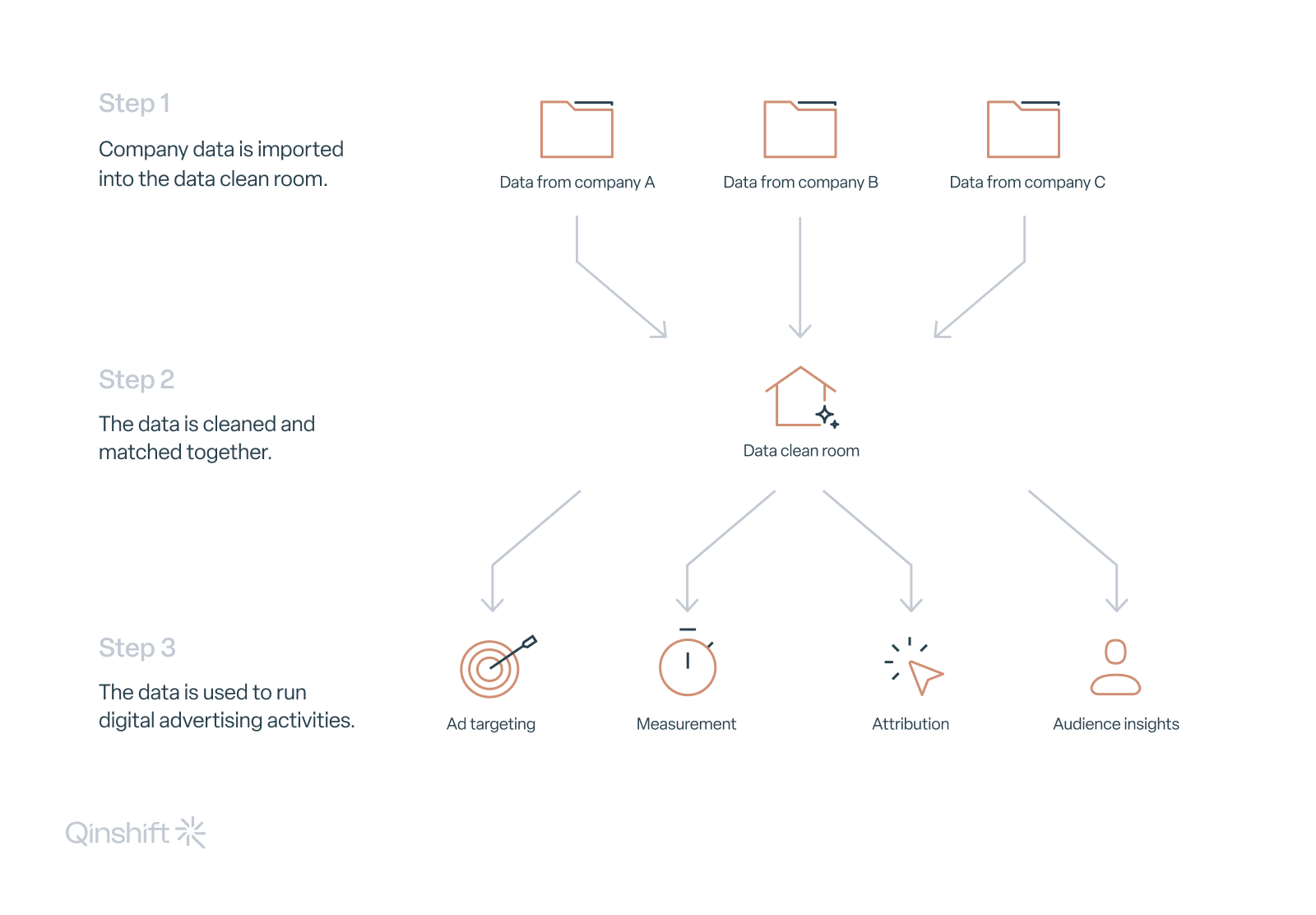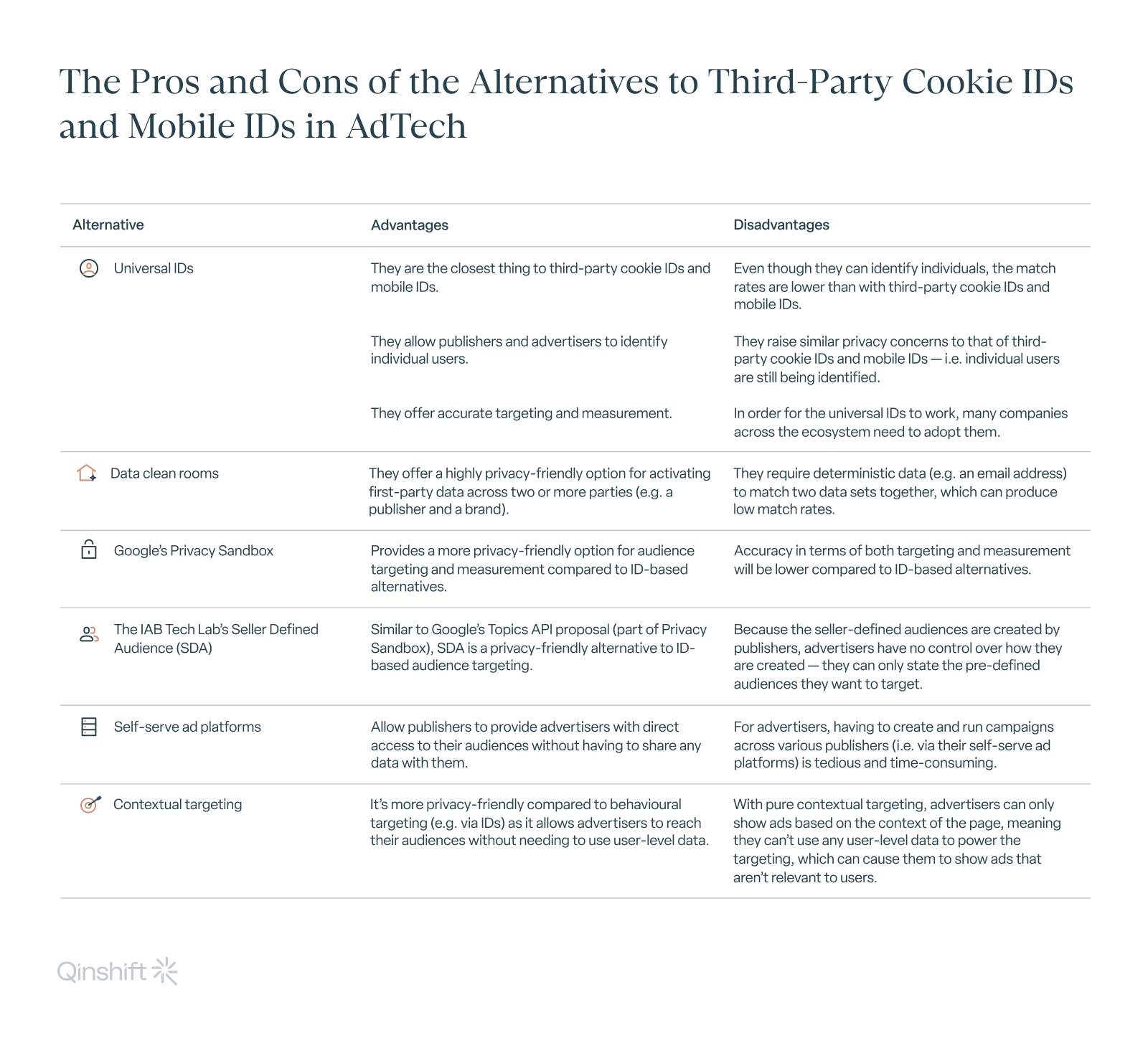What Is a Data Clean Room and How Does It Work?

Ever wondered how advertisers can tailor ads just for you without invading your privacy?
It’s thanks to data clean rooms — the secret hubs where brands fine-tune their marketing strategies while keeping your data safe.
In this article, we’ll explain what data clean rooms are, explore their importance in modern advertising, and introduce you to the key players driving this evolution.
Key Points
Data clean rooms safeguard personal information by analysing aggregated datasets instead of sharing individual user details. This ensures privacy while allowing effective advertising strategies.
Clean rooms enable businesses from different sectors to collaborate by sharing anonymised datasets. This collaboration provides insights into advertising performance and consumer behaviour without compromising privacy.
Amid the decline of third-party cookies, data clean rooms emerge as a privacy-conscious alternative for targeted advertising. Alongside other solutions like universal IDs and contextual ad targeting, clean rooms ensure effective advertising while respecting user privacy concerns.
What Is a Data Clean Room?
A data clean room (DCR) serves as a secure hub for brands and advertisers to manage targeted advertising efforts while respecting user privacy.
DCRs operate by allowing advertisers and brands to upload their own data, which is then compared with aggregated data contributed by other parties. This comparison enables them to refine their campaigns, set limits on ad frequency, analyse performance, and track attribution without compromising individual user information.
Data clean rooms operate differently than conventional data partnerships that involve direct exchanges of detailed user data like cookie IDs or device IDs. Instead of sharing sensitive user-level data outside its confines, a DCR matches and analyses aggregated datasets within a secure environment.
This ensures that all data remains protected and inaccessible to external parties, maintaining privacy standards while maximising advertising effectiveness.
How Does a Data Clean Room Work?
To understand how data clean rooms function, imagine a metal box moving along a conveyor belt.
Here’s how it operates:
1. Loading: Advertisers place their data on the belt, which can include information about users and past transactions. On the other end, another party does the same.
2. Cleaning: The belt transports the data to a metal box, which represents the data clean room. Inside, the data from both parties is processed and sanitised, including matching audiences and applying privacy techniques like encryption and limiting access.
3. Ready to Use: After processing, the data is ready for use. Advertisers can target their desired audience and receive reports for analysis. Importantly, the reports are based on aggregated data to protect privacy. For instance, while you’ll know how many people clicked on your ads, you won’t receive any personal information about them.

Following this process, data can be put to use for advertising and marketing purposes like targeting specific audiences and analysing their behaviour.
Advertisers and publishers can examine reports provided by the data clean room to enhance their current or future campaigns.
Why Are Brands Using (and Building) Data Clean Rooms?
Three different trends, particularly notable in the retail sales sector, have emerged in the development of data clean rooms:
1. Focusing on Gathering Retailer Loyalty Card Data
Hershey’s is adapting their advertising approach by aiming to collect fresh insights into their ad campaigns’ performance. Despite selling their products through various retailers, Hershey’s lacks crucial information, such as the effectiveness of their loyalty programs.
To address this gap, Hershey’s has established their own data clean room. This allows the company to persuade retailers to share their first-party data, enabling Hershey’s to assess the impact of their advertising efforts, analyse loyalty program effectiveness, and refine their marketing strategies. Retailers store loyalty card data alongside Hershey’s ad data within the data clean room, facilitating collaborative analysis.
2. Tackling Cross-Platform Measurement Challenges
Unilever is utilising a data clean room to identify instances where ad content shown across different platforms failed to drive positive retail outcomes for the same user. To achieve this, Unilever shares their ad-related records and datasets with measurement companies Nielsen and Kantar, who then conduct cross-platform analyses involving major platforms like Google, Facebook, and Twitter.
3. Enhancing Advertising Solutions
Disney has introduced their own data clean room solution to offer tailored and forward-thinking marketing solutions to advertisers. Through partnerships with data clean vendors Habu, InfoSum, and Snowflake, Disney provides their advertising clients with a privacy-conscious method to engage Disney’s audience and gain valuable consumer insights.
The Pros and Cons of Other Privacy Alternatives in AdTech
Over the past few years, there’s been a decline in the use of third-party cookies. Recently, Google Chrome, the most popular web browser, announced it’s phasing out support for these cookies. This led to the rise of alternatives to them, like data clean rooms.
Instead of relying on third-party cookies, people are turning to different options:
Universal IDs: Instead of cookies, these use email addresses to create unique IDs. It helps advertisers target users without relying on cookies.
Google Chrome’s Privacy Sandbox: Google is working on new standards to protect user privacy while still allowing ads. One of these is the Topics API, which shows ads based on what users are interested in.
Contextual ad targeting: This method looks at the content of a web page or app to decide which ads to show. It’s an old but effective way of targeting ads.
There are also new ideas for the future, like cryptoidentities. These use avatars to represent people online, allowing data to be used without sharing personal info.
If you want to explore those and more privacy alternatives, along with their advantages and disadvantages, check out the table below:

What’s the Difference Between a Customer Data Platform and a Data Clean Room?
Advertisers and publishers gather important information about their audiences using special platforms called customer data platforms (CDPs). These platforms help them collect and organise data they get directly from their users.
However, data clean rooms take data management even further. Here’s how the two are different:
1. CDPs focus on gathering individual user data and IDs. Data clean rooms, on the other hand, deal with anonymised data, meaning the personal details are hidden.
2. While CDPs include security measures to control who can access the data, they can still be at risk of data leaks. Data clean rooms are more secure because they use advanced techniques to anonymise the data, making it much harder to trace back to individuals.
3. With a CDP, you’re limited to analysing only the data from your own company. But data clean rooms allow you to look at combined data from multiple sources, giving you broader insights without revealing anyone’s personal information.
What Kinds of Data Clean Rooms Are There?
Currently, there are two main kinds of DCRs in the AdTech industry: centralised and decentralised.
In centralised data clean rooms, all the data is kept in one place. In decentralised ones, the data is spread out across different locations, like separate servers.
In a centralised clean room setup, data is transferred from its original location to a central server controlled by another party. This party then handles the data processing, shifting the responsibility from the data owner to them. However, the specifics of how the data is managed and returned aren’t always clear.
On the other hand, in a decentralised clean room approach, the system utilises distributed ledger techniques. This means that all participants who contribute data have access to and can observe the data being used and processed.
Here’s how a decentralised data clean room typically works:
1. Both parties, like a publisher and an advertiser, encrypt their own data and upload it to the data clean room.
2. The data clean room then looks for similarities between the two sets of data. It might compare hashed email addresses, phone numbers, or mobile IDs, for example, and find matches.
3. Once the data is matched up, it can be used for things like targeted advertising, measuring campaign effectiveness, and performing analyses.
What Types of Companies Offer Data Clean Rooms?
Data clean rooms come in three types:
the ones from big AdTech companies,
others from independent companies,
some built by companies with lots of users.
The first kind is found in AdTech walled gardens like Google, Amazon, and Facebook. These companies operate closed-off spaces where they handle data, which they then give to businesses using their advertising services in a form that’s been made anonymous and combined.
The second kind is seen in independent AdTech firms such as LiveRamp, Snowflake, Aquilliz, and Decentriq. These companies offer businesses ready-made data spaces that can be used across various industries and digital advertising platforms. This type, offered by companies like InfoSum, is neutral ground where two parties, like a publisher and an advertiser, can safely share data.
The third kind, built by companies like Disney, Spotify, and TikTok, are their own clean rooms using their vast user data.
Looking for AdTech & MarTech development services?
Discover how our teams can help you design, build and maintain advertising and marketing software.

